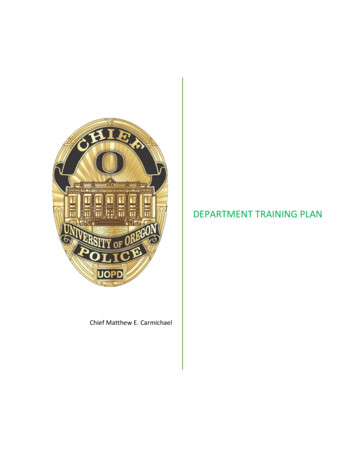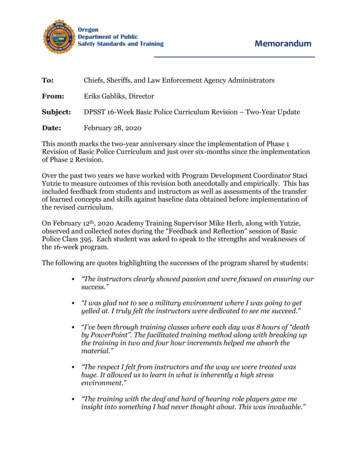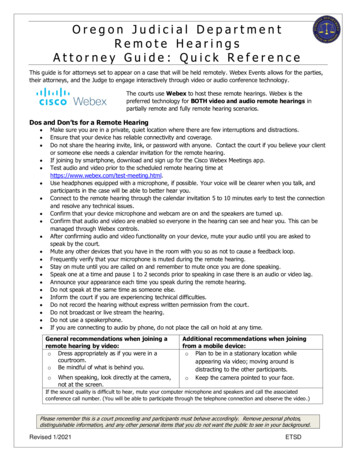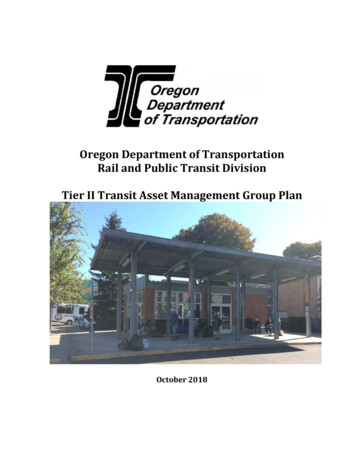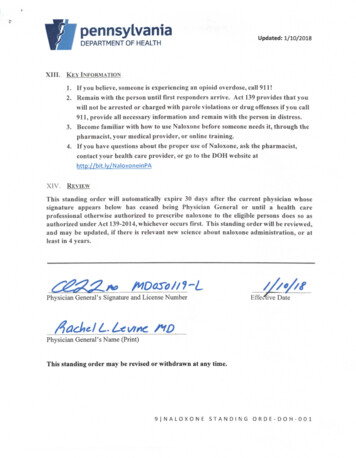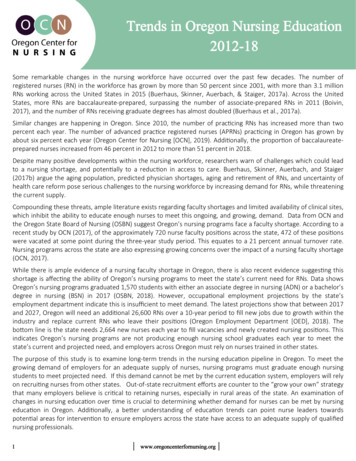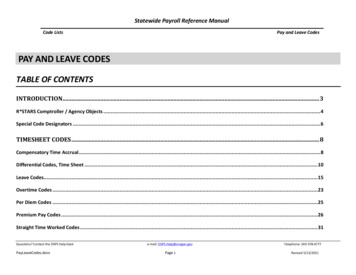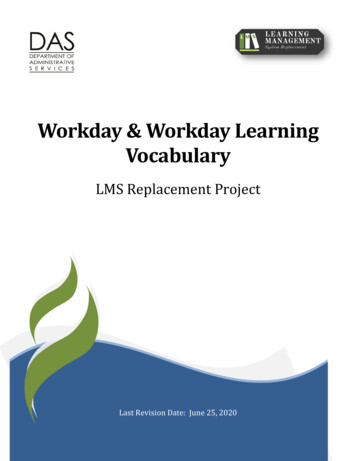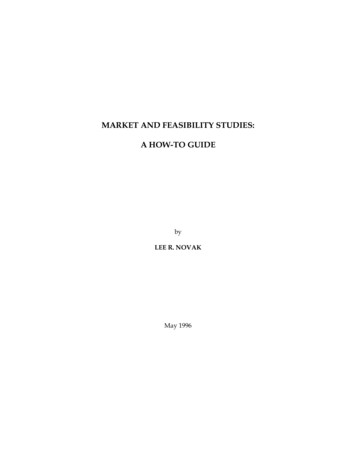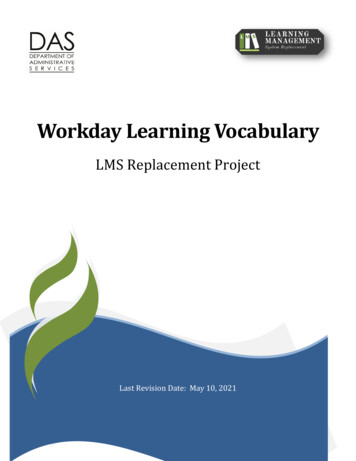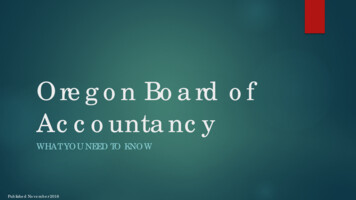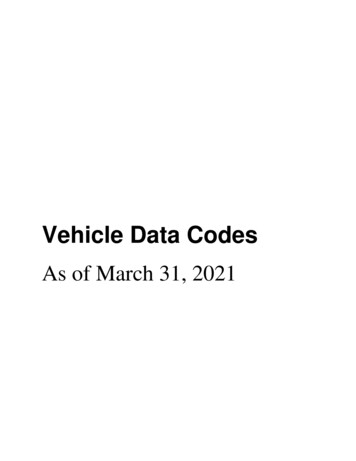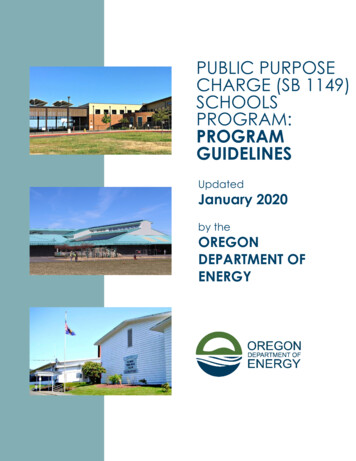
Transcription
PUBLIC PURPOSECHARGE (SB y 2020by theOREGONDEPARTMENT OFENERGY
SB 1149 PROGRAM GUIDELINES - 2020Table of ContentsIntroduction . 4Collection, Distribution and Utilization of Funds . 5Facilities . 5Eligible Facilities . 5Excluded Facilities . 6Ineligible Facilities. 6Energy Audit Requirements . 6Program Energy Audits . 7Determining the Audit Types . 7Whole Building Energy Audit . 7Targeted Energy Audit . 7Energy Use Index (EUI) Targets for Schools . 8Waivers . 8New Facilities. 8Facilities Requiring an Updated Energy Audit . 9Energy Audit Reports . 9Eligible Energy Audit Costs. 9Energy Efficiency Measure Life . 9Fleet Audit Requirements . 10Energy Audit Measure Implementation . 10Implementation Plan . 10Other Measure Implementation . 11Eligible Costs. 11Maximum Reimbursement of PPC Funds . 11Commissioning . 12Fleet Audit Implementation . 12Administrative Expenses . 12Reporting Requirements . 14Annual Eligibility Reporting . 14Annual Energy Use Reporting . 14Audit Reporting . 14Audit Implementation Plan . 14Implemented Audit Measures Reporting. 15Energy Education Reporting . 15Environmentally Focused Fuel Sources Reporting . 15Renewable Resource Reporting . 15Other Financial Incentives . 15Energy Trust of Oregon . 162
SB 1149 PROGRAM GUIDELINES - 2020Financial Requirements . 16Revenues . 16Expenditures . 16Expenditure Documentation . 17Program Verification and Quality Control . 18Verification and Quality Control of Audits . 18Verification and Quality Control of Implemented Measures . 18Definitions . 19Revision History . 23Appendix A – Measure Life Table . 25Appendix B – Multi-component Measure Life Calculator . 273
IntroductionThe SB 1149 Schools Program was created when the Oregon Legislature passed Senate Bill 1149in the 1999 legislative session. The bill went into effect on March 1, 2002. It provides thatPortland General Electric and Pacific Power must collect a “Public Purpose Charge” (PPC) fromconsumers within their service areas that is equal to three percent of the total revenues fromelectricity services. The first ten percent of these PPC funds must go towards energy efficiencyefforts in eligible public kindergarten through twelfth grade (K-12) school facilities within theirservice areas. The Oregon Department of Energy (ODOE) is the Program administrator of the SB1149 Schools Program (Program) and works in cooperation with public K-12 school districts inPortland General Electric and Pacific Power service territories.Program Guidelines were first developed in March 2002 to assist K-12 school districts in theimplementation of cost-effective energy efficiency improvements in schools utilizing PublicPurpose Charge funds. Since then, the Program Guidelines were revised in 2005, 2008, 2011,2013, 2015, 2016 and most recently in 2017 (see Revision History).Program Guideline revisions are the outcome of stakeholder collaboration with ODOE toupdate technical information and increase program process efficiencies.The adopted Guideline revisions include: School districts can work with Energy Trust programs to submit energy measure savingsfor consideration through the Program after the Program’s requirement to complete anenergy audit has been met for each school School districts may still combine PPC funds and Energy Trust incentives on eligiblemeasures but the combined funding is no longer capped at maximum reimbursementamount. Energy Trust incentives can be added to the maximum reimbursement amount,but never to exceed 100% of the project cost School districts may complete a fleet audit and can use PPC funds to purchase or leaseZero-Emissions Vehicles and to purchase or install charging stations
SB 1149 PROGRAM GUIDELINES - 2020Collection, Distribution and Utilization of FundsOregon law1 established a public purpose charge (PPC) of three percent of the total revenuescollected from the retail electric customers within Portland General Electric and Pacific Powerterritories. The first ten percent of the PPC funds collected annually must be distributed toschool districts located in the service territories of these two electric companies. PPC fundsprovide reimbursement2 for the cost-effective portion of energy efficiency improvements,energy education, the purchase of environmentally focused energy, and Renewable EnergyResource Projects in Oregon K-12 public schools in Portland General Electric and Pacific Powerservice territories. By law3, the Program continues through the end of 2025.PPC funds are distributed monthly to the school districts directly by the electric companies.Distributed PPC funds are calculated according to the Weighted Average Daily Membership ofthe individual school district for the prior fiscal year4.By law, PPC funds must be used by school districts in the following manner: First, Energy Audits of eligible educational facilities or a fleet audit of school districtmust be completed and approved by the Oregon Department of Energy. Next, school districts may use the funds to implement approved:o Energy Efficiency Measures; ando Purchase or lease Zero-Emission vehicles (including buses); ando Install electric vehicle charging stations Finally, once all approved Energy Efficiency Measures have been implemented, a schooldistrict may conduct new Energy Audits and energy conservation education programs ateligible educational facilities.FacilitiesEligible FacilitiesOnly school district facilities which meet each of the following criteria are eligible for PPC funds:1) Must be served by Portland General Electric or Pacific Power; and2) Must be owned by the Public School District; and1Senate Bill 1149 (1999) SectionSchool districts must pay for implementation of eligible Energy Efficiency Measures with non-PPC funds before theymay be reimbursed for the cost-effective portion of the Eligible Energy Efficiency Measure.3 Senate Bill 838 (2007)4 As calculated under ORS 327.013. The Public Utility Commission has established by rule a methodology fordistributing a proportionate share of funds to Education Service Districts that are partially located in the serviceterritories of the electric companies.25
SB 1149 PROGRAM GUIDELINES - 20203) Must be a K-12 Instructional School Facility; and4) The Weighted Average Daily Membership for the facility must be included at the schooldistrict and/or Educational Service District by the Oregon Department of Education.Excluded FacilitiesSchool district facilities which meet any of the following criteria are excluded from using PPCfunds:1) Owned and operated by a school district but are destined for closure within 5 years; or2) Owned and operated by a school district but are leased out for non-educationalpurposes.Ineligible FacilitiesSchool district facilities which meet any of the following criteria are ineligible from using PPCfunds:1) Leased, but not owned, by a school district; or2) Not served by Portland General Electric or Pacific Power territories are not eligible forPPC funds.Exclusion from the Energy Audit requirement of any eligible Instructional School Facilityrequires both an annual Energy Audit waiver approved by the Oregon Department of Energyand annual written notification to the Oregon Department of Energy on the status of thefacility.Energy Audit RequirementsSchool districts are required to complete Energy Audits of eligible Instructional School Facilitiesto identify and analyze measures.Each eligible Instructional School Facility will be considered to have met the energy auditrequirement if they have:1) Completed a Whole Building Energy Audit; or2) Completed multiple Targeted Energy Audits that, through a combination of datacollected and analyzed measures, is equivalent to a Whole Building Energy Audit; or3) Received a waiver from Oregon Department of Energy for an Energy AuditOnce eligible Instructional School Facilities have met the energy audit requirement, a schooldistrict can work with Energy Trust to complete one of the paths below to identify additionalenergy measures that can be considered for the Program. Energy Trust paths to identifyadditional measures include:1) Custom study path (which may include a Technical Analysis Study (TAS)); or2) Prescriptive measures path; or3) Lighting measures path.6
SB 1149 PROGRAM GUIDELINES - 2020Only measures that have been analyzed by a Qualified Energy Auditor and approved by theOregon Department of Energy are eligible for reimbursement.Program Energy AuditsEnergy Audits that school districts request reimbursement through school district PPC fundsmust be conducted according to the Oregon Department of Energy regon/Pages/SB1149-Program-Guidelines.aspx) andperformed by a Qualified Energy Auditor.The Oregon Department of Energy maintains a current list of Qualified Energy Auditors on itswebsite: chools-Audit-Firms.aspxDetermining the Audit TypesTwo types of energy audits are used in the Program to assess a facility’s energy savingpotential, Whole Building Energy Audits and Targeted Energy Audits. The Whole Building EnergyAudit is similar to the ASHRAE Level 2 audit, with some modifications.More details about energy audit types and requirements are available in the Energy AuditRequirements located on the ODOE SB 1149 website: chools-Audit-Firms.aspxPrior to execution of a contract to conduct an Energy Audit with a Qualified Energy Auditor aScope of Work Approval Form must be submitted to the Oregon Department of Energy forreview and approval. The Oregon Department of Energy will send written approval for asubmitted Scope of Work Approval Form and may require clarifications and revisions before anEnergy Audit may be conducted.Whole Building Energy AuditThis audit includes a detailed building survey and energy analysis. The Whole Building EnergyAudit identifies a list of potential EEMs that are likely to have a Simple Payback less than 50years. A breakdown of energy use by system is required. All facility equipment and systems arereviewed to evaluate and confirm equipment and system operating profiles, methods ofcontrol, equipment efficiency, and changes of facility energy usage that have occurred or areanticipated. It includes calculations to support energy savings, costs, and Simple Payback. Itmay include energy modeling in addition to or as a substitute for Bin calculations. It will alsoidentify low-cost/no-cost operations, maintenance and operation (O&M) procedures, andcapital equipment and installation costs.Targeted Energy AuditThis audit includes an investigation or analysis with a limited scope, typically of a single area ofthe building, system, or measure (e.g., lighting, boiler controls, cooling tower). This is typicallydone when a facility has already completed a Whole Building Energy Audit and needs to includeor update a measure for future implementation. The level of effort may be tailored for the7
SB 1149 PROGRAM GUIDELINES - 2020specific scope of work, but for the item(s) being audited or analyzed all other specificrequirements for a Whole Building Energy Audit must be followed. Any deviations need to bereviewed and approved by ODOE prior to approval of the Targeted Energy Audit scope of work.Energy Use Index (EUI) Targets for SchoolsFor schools that do not currently meet the specified targets, the Energy Auditor must makeevery reasonable attempt to identify EEMs that, if implemented, would help a facility reach orsurpass specified annual EUI targets.1.2.ANSI/ASHRAE/IES Standard 100-2015 Energy Efficiency in Existing Buildings, Table 7-2 Building Activity EnergyTargets. The lower target represents the value in this ASHRAE table 7-2 with adjustments to incorporate thelower factor for schools from ANSI/ASHRAE/IES Standard 100-2015 Energy Efficiency in Existing Buildings,Table 7-3 Building Operating Shifts Normalization Factor.ANSI/ASHRAE/IES Standard 100-2015 Energy Efficiency in Existing Buildings, Table 7-2 Building Activity EnergyTargets. The upper target represents the value in this ASHRAE table 7-2 with adjustments to incorporate thehigher factor for schools from ANSI/ASHRAE/IES Standard 100-2015 Energy Efficiency in Existing Buildings,Table 7-3 Building Operating Shifts Normalization Factor.WaiversEnergy audit waivers for Instructional School Facilities may be obtained for the followingfacilities:1) A facility that meets or surpasses the EUI target; and/or2) A facility that is destined for closure within five years or the foreseeable future; and/or3) Any facility that is leased by a school district to another entity.A school district must request an Energy Audit waiver annually by written notification to theOregon Department of Energy. The Oregon Department of Energy will review and approve ordeny all waivers in writing. Waived status may be removed from a facility by contacting theOregon Department of Energy.No measures may be reimbursed with PPC funds for waived facilities.New FacilitiesA school district must inform the Oregon Department of Energy of the construction of any newInstructional School Facilities. New Instructional School Facilities automatically receive anEnergy Audit waiver for the first two years of operation. Annual energy use must be entered for8
SB 1149 PROGRAM GUIDELINES - 2020a new facility beginning in the first year of operation. The second year of billing data followingconstruction of the new facility will be used to establish a Baseline EUI for the facility. Startingwith the third year of operation and beyond, the facility will follow the same process forconducting an Energy Audit and implementing EEMs.Facilities Requiring an Updated Energy AuditFor facilities with Energy Audits older than 5 years, school districts must determine if theexisting Energy Audit Report and associated EEMs that have not already been implemented arestill valid. Large variances or changes from the conditions described in the approved EnergyAudit Report to current conditions (e.g., EUI, facility conditions, existing systems) may becriteria to consider when reviewing the validity of the Energy Audit Report and EEMs. Toconfirm if existing Energy Audit Report or EEMs are still valid contact the Oregon Department ofEnergy.Energy Audit ReportsAll Energy Audits must result in the creation of an Energy Audit Report. The Report is a detaileddocument prepared by a Qualified Energy Auditor that includes a summary ofrecommendations, building and energy using system descriptions, cost and savings of EEMs,and supporting calculations and details.Eligible Energy Audit CostsEligible Energy Audit costs are expenses for performing approved Energy Audits conducted by aQualified Energy Auditor that identify measures. All Energy Audits that comply with therequirements of the Program (including a Scope of Work Approval Form approved by theOregon Department of Energy before the audit is conducted) and culminate in an Energy AuditReport approved by the Oregon Department of Energy are eligible for reimbursement with PPCfunds.Energy Audit costs that exceed 10% of a facility’s total annual energy costs may be subject toadditional review and be required to submit additional documentation for justification ofadditional cost.Energy Efficiency Measure LifeMeasure Life is considered the number of years an EEM is estimated to remain in service whileproviding the expected energy savings. Energy savings will likely continue well after MeasureLife, but may be less than expected.The Program has developed a Measure Life Table (see Appendix A – Measure Life Table) usingmultiple, peer-reviewed sources as well as data contained in the School Interactive Database.The Measure Life Table contains all values used in the Program.Multi-component measures are measures with multiple, but distinct components, each withtheir own measure lives that cannot be separated for technical or practical reasons. Themeasure life for a multi-component measure is a weighted average o
School districts may complete a fleet audit and can use PPC funds to purchase or lease Zero-Emissions Vehicles and to purchase or install charging stations . SB 1149 PROGRAM GUIDELINES - 2020 . district may conduct new Energy Audits and energy conservation education programs at eligible educational facilities.
